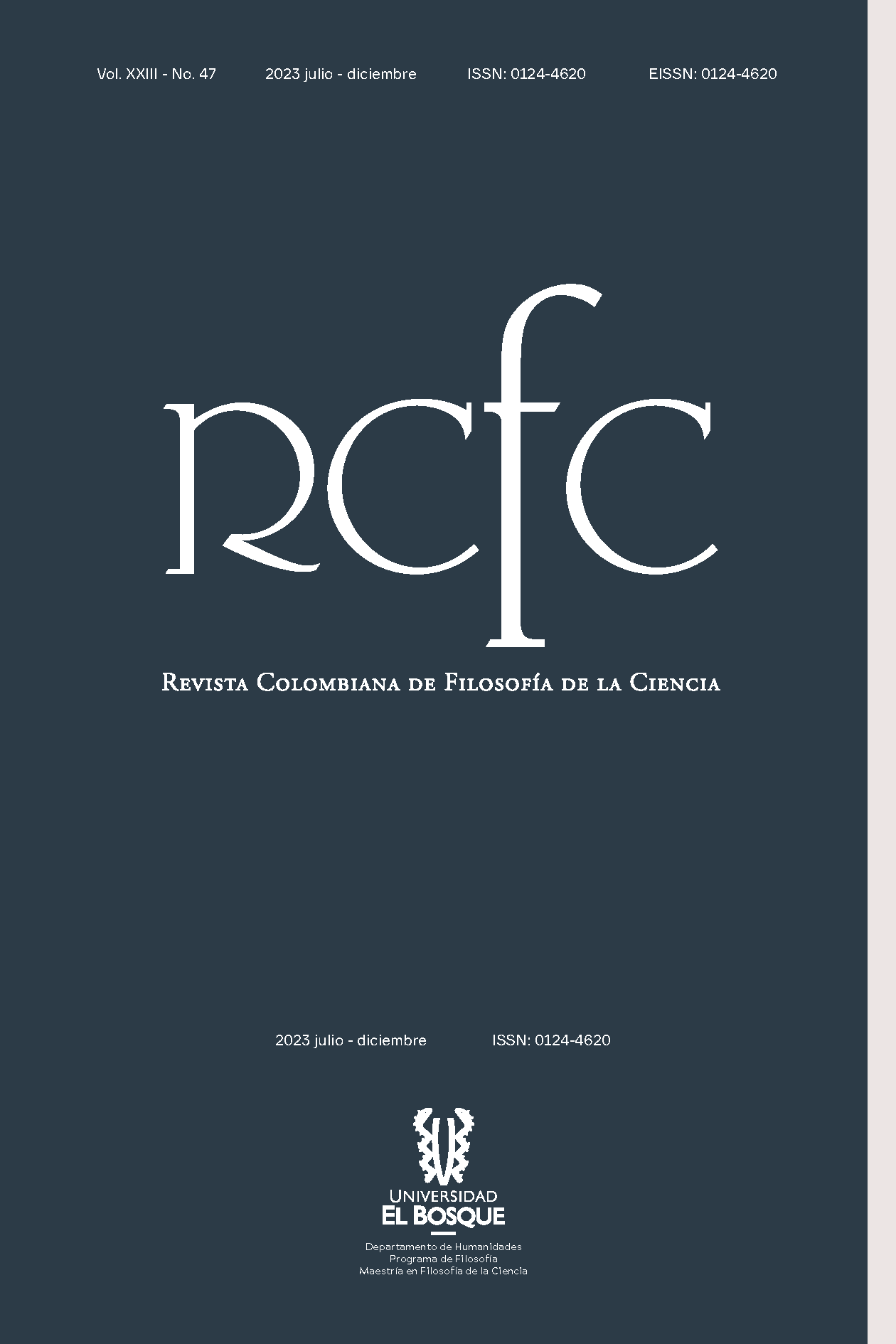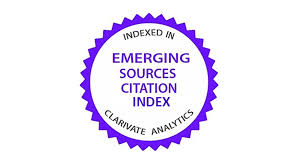Trans-estadística cuántica desde una ontología de propiedades
DOI:
https://doi.org/10.18270/rcfc.v23i47.4186Palabras clave:
filosofía de la física, partículas virtuales, bosones compuestos, estructura producto tensorial, ontología de propiedadesResumen
En los últimos años, el comportamiento bosónico que un sistema de fermiones puede exhibir ha despertado el interés de los físicos. En este trabajo, se adopta un enfoque basado en estructuras producto tensorial y se asume una ontología de propiedades para argumentar en favor de la relatividad de la noción de identidad estadística y en favor de una interpretación realista del comportamiento trans-estadístico.
Descargas
Referencias bibliográficas
Avancini, S., Marinelli, J. R. y Krein, G. “Compositeness Effects in the Bose–Einstein Condensation”. Journal of Physics A: Mathematical and General 36.34 (2003): 9045-9052. <https://www.doi.org/10.1088/0305-4470/36/34/307>
Ballentine, Leslie. Quantum Mechanics: A Modern Development. Singapore: World Scientific, 1998.
Belkhir, Lotfi. y Randeria, Mohit. “Collective Excitations and the Crossover from Cooper Pairs to Composite Bosons in the Attractive Hubbard Model”. Physical Review B: Condensed Matter 45.9 (1992): 5087. <https://doi.org/10.1103/PhysRevB.45.5087>
Brooks, James S. y Donnelly, Russell J. “The Calculated Thermodynamic Properties of Superfluid Helium‐4”. Journal of Physical and Chemical Reference Data 6.1 (1977): 51-104. <https://doi.org/10.1063/1.555549>
Butterfield, Jeremy. “Interpretation and Identity in Quantum Theory”. Studies in History and Philosophy of Science 24.3 (1993): 443-476. <https://doi.org/10.1016/0039-3681(93)90037-K>
Chudzicki, Christopher., Oke, Olufolajimi., y Wootters, William K. “Entanglement and Composite Bosons”. Physical Review Letters 104 (2010): 070402-070402.
Combescot, M. y Tanguy, C. “New Criteria for Bosonic Behavior of Excitons”. Europhysics Letters 55.3 (2001): 390-396. <https://doi.org/10.1209/epl/i2001-00427-7>
Cuestas, Eloisa., Bouvrie, P. Alexander., y Majtey, Ana P. “Fermionic versus Bosonic Behavior of Confined Wigner Molecules”. Physical Review A 101 (2020): 033620 <https://doi.org/10.1103/PhysRevA.101.033620>
da Costa, Newton., y Lombardi, Olimpia. “Quantum Mechanics: Ontology without Individuals”. Foundations of Physics: An International Journal Devoted to the Conceptual Bases and Fundamental Theories of Modern Physics 44 (2014): 1246-1257. <https://doi.org/10.1007/s10701-014-9793-1>
da Costa, Newton., Lombardi, Olimpia., y Lastiri, Mariano. “A Modal Ontology of Properties for Quantum Mechanics”. Synthese 190.17 (2013): 3671-3693. <https://www.jstor.org/stable/24019905>
Dugić, M., y Jeknić, J. “What is ‘system’: Some Decoherence-Theory Arguments”. International Journal of Theoretical Physics 45 (2006): 2215–2225. <https://doi.org/10.1007/s10773-006-9186-0>
Dugić, M. y Jeknić-Dugić, J. “What is «system»: The Information-theoretic Arguments”. International Journal of Theoretical Physics 47 (2008): 805-813. <https://doi.org/10.1007/s10773-007-9504-1>
Earman, John. “Some Puzzles and Unresolved Issues about Quantum Entanglement”. Erkenntnis 80.1 (2015): 303-337. <https://doi.org/10.1007/s10670-014-9627-8>
Fortin, Sebastian y López, Cristian. “Problemas ontológicos de la mecánica cuántica”. Diccionario Interdisciplinar Austral. Eds. Claudia E. Vanney, Ignacio Silva y Juan F. Franck, 2016. Online. <http://dia.austral.edu.ar/Problemas_ontológicos_de_la_mecánica_cuántica>
Fortin, Sebastián., y Lombardi, Olimpia. “Entanglement and Indistinguishability in a Quantum Ontology of Properties”. [Preprint] (2021): Online. <http://philsci-archive.pitt.edu/19257/>
French, Steven. “Identity and Individuality in Classical and Quantum Physics”. Australasian Journal of Philosophy 67.4 (1989): 432–446. <https://doi.org/10.1080/00048408912343951>
Gigena, N., y Rossignoli, R. “Entanglement in Fermion Systems”. Physical Review A 92 (2015): 042326. <https://doi.org/10.1103/PhysRevA.92.042326>
Harshman, N. L., y Wickramasekara, S. “Tensor Product Structures, Entanglement, and Particle Scattering”. Open Systems and Information Dynamics 14.3 (2007): 341–351. <https://doi.org/10.1007/s11080-007-9057-z>
Kochen, Simon y Specker, E. “The Problem of Hidden Variables in Quantum Mechanics”. Journal of Mathematics and Mechanics 17.1 (1967): 59-87
<https://doi.org/10.1512/iumj.1968.17.17004>
Krause, Décio. “On a Quasi-set Theory”. Notre Dame Journal of Formal Logic 33.3 (1992): 402–411. <http://dx.doi.org/10.1305/ndjfl/1093634404>
Law, C. K. “Quantum entanglement as an Interpretation of Bosonic Character in Composite Two-particle Systems”. Physical Review A 71.3 (2005): 034306. <https://doi.org/10.1103/PhysRevA.71.034306>
Laycock, Henry. “Object.” Stanford Encyclopedia of Philosophy (Winter 2014 Edition). Ed. Edward N. Zalta. Stanford, Stanford University, 2017. <https://plato.stanford.edu/archives/win2014/entries/object/>
Lombardi, Olimpia. y Castagnino, Mario. “A Modal-Hamiltonian Interpretation of Quantum Mechanics”. Studies in History and Philosophy of Modern Physics 39 (2008): 380-443. <https://doi.org/10.1016/j.shpsb.2008.01.003>
Lombardi, Olimpia., y Pasqualini, Matías Daniel. “La controversia acerca de la identidad en su ingreso al ámbito de la mecánica cuántica”. Ideas y Valores 71.8 (2022): 138-164. <https://doi.org/10.15446/ideasyvalores.v71n8Supl.102872>
Lombardi. Olimpia. y Dieks, Dennis. “Particles in a Quantum Ontology of Properties”. Metaphysics in Contemporary Physics. Eds. Tomasz Bigaj., y Chritian Wüthrich. Leiden: Brill-Rodopi, 2016. 123-143. <https://doi.org/10.1163/9789004310827_007>
Muller, F. A., y Saunders, S. “Discerning Fermions”. The British Journal for the Philosophy of Science 59.3 (2008): 499–548. <http://dx.doi.org/10.1093/bjps/axn027>
Rombouts, S, Van Neck, D., Peirs, K. y Pollet, L. “Comment on New criteria for Bosonic Behavior of Excitons by M. Combescot and C. Tanguy”. Europhysics Letters 63.5 (2003): 785. <https://doi.org/10.1209/epl/i2003-00589-8>
Tichy, Malte C., Bouvrie, Alexander P., y Mølmer, Klaus. “How Bosonic is a Pair of Fermions?” Appl. Phys. B 117 (2014): 785-796. <https://doi.org/10.1007/s00340-014-5819-9>
van Fraassen, Bas. “Statistical Behaviour of Indistinguishable Particles: Problems of Interpretation”. Recent Developments in Quantum Logic. Eds. Mittelstaedt, Peter. y Stachow, Ernst-Walther. Mannheim, 1985. 161-187.
Weyl, Hernan. The Theory of Groups and Quantum Mechanics. London: Methuen and Co., English trans., 2nd edition, 1931.
Zanardi, Paolo. “Virtual Quantum Systems”. Physical Review Letters 87.7 (2001): 077901. <https://doi.org/10.1103/PhysRevLett.87.077901>
Descargas
Publicado
Cómo citar
Número
Sección
Licencia

Esta obra está bajo una licencia internacional Creative Commons Atribución-NoComercial-SinDerivadas 4.0.

| Estadísticas de artículo | |
|---|---|
| Vistas de resúmenes | |
| Vistas de PDF | |
| Descargas de PDF | |
| Vistas de HTML | |
| Otras vistas | |











